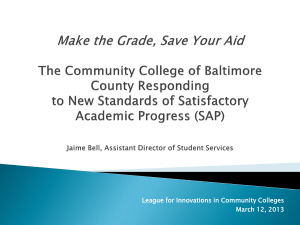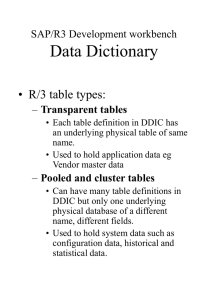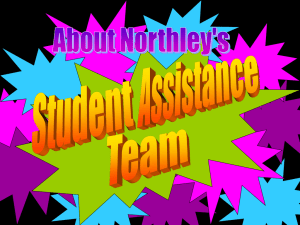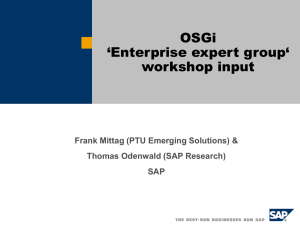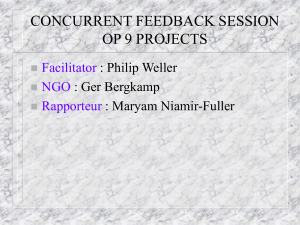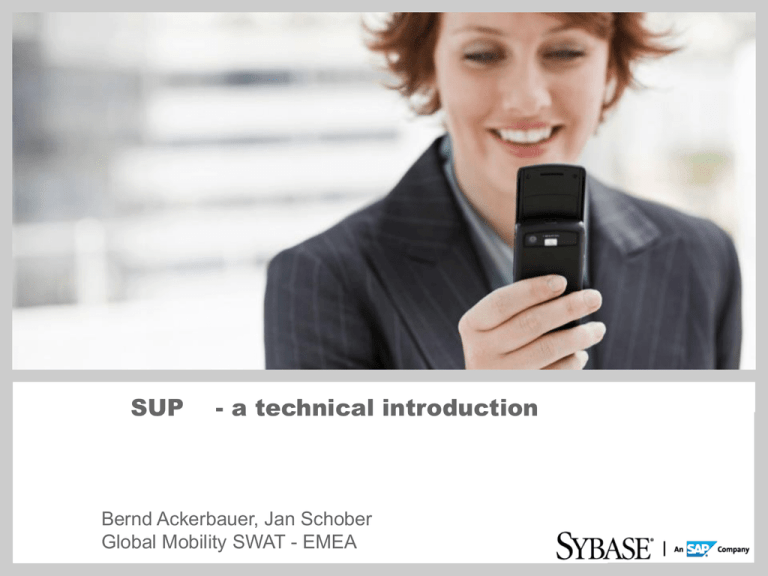
SUP
- a technical introduction
Bernd Ackerbauer, Jan Schober
Global Mobility SWAT - EMEA
AGENDA
1. Technical introduction to Sybase MEAP
2. Application development with SUP
3. Summary
©
2010 SAP AG. All rights reserved. / Page 2
Sybase Unwired Platform
TECHNICAL OVERVIEW
Address Complexity Across the Enterprise
©
2010 SAP AG. All rights reserved. / Page 4
Device Management
- vital part of every mobile strategy
©
2010 SAP AG. All rights reserved. / Page 5
Afaria
- Managing and Securing the Device Lifecycle
Manage
Assign membership/policies
Manage
Configure devices
Track asset
OTA client delivery
Update/repair software
Application deployment
Maintain/modify configuration
Secure
Distribute/update files
Establish policies
Software license tracking
Initialize power-on password
Schedule/automate activities
Install and encrypt data
Device remote control
Install and configure AV, firewall,
controls
Secure
Back-up data
Apply patch/security updates
Enforce security policies
Monitor/track security violations/threats
©
Secure
Manage
Disable lost/stolen device
Reprovision/reimage device
Remote kill/lock
Replacement device-same user
Access violation lock
Repurposed device
“Data fading”
Redeploy software assets
Disable device, network,
application access
Restore data (after device kill)
2010 SAP AG. All rights reserved. / Page 6
Compliance activity logging
How does SUP help reduce TCO?
Application
Development
Infrastructure
Platform Services
•
•
•
•
•
Windows Mobile
BlackBerry
iPhone
iPad
Android
•
Connection management
Data security (on device and OTA)
Version control
Seamless online/offline use
Data synchronization
Application integration
Device detection and management
Logging & reporting
•
•
•
•
•
•
•
©
2010 SAP AG. All rights reserved. / Page 7
SUP native application
development
Basic application types
- native apps
With SUP you can create two application types
SUP
Native
Apps
SUP
HWC
Apps
©
2010 SAP AG. All rights reserved. / Page 9
SUP native applications
- overview
Best fit: High degree of task specialization and data intensive offline
usage
Device Support
BlackBerry
Windows
iOS
(RIM Java ME)
and Windows Mobile (C#)
(Objective C)
Android
(road map)
Characteristics
Self-contained:
Full
Offline capabilities
Large
amount of local data possible
Complex
Client
©
No browser/container App etc. needed
Business Logic can be covered
coding required
2010 SAP AG. All rights reserved. / Page 10
SUP native applications
- app development task flow
Data
modeling
©
2010 SAP AG. All rights reserved. / Page 11
Deploy
to SUP
Generate
Source code
Develop app
using SUP API
Compile
SUP native applications
- development tasks
1.
Data modeling of backend sources
2.
Graphical tooling
Multiple backends
Application developer uses data model
Developer can focus on application development
No need to work on data storage, persistance, synchronisation, etc
2
1
©
2010 SAP AG. All rights reserved. / Page 12
Basic application types
- native apps
With SUP you can create two application types
SUP
Native
Apps
SUP
HWC
Apps
©
2010 SAP AG. All rights reserved. / Page 13
SUP Hybrid Web Container applications
- overview
Best fit: Simple applications and workflows
Device Support
BlackBerry
Windows
Mobile
iOS
Android
Characteristics
Fast
to develop and to deploy
Offline
No
or minor application logic (JS)
No
native client coding required
Base
©
capabilities
HTML workflow for cross platform compatibility
2010 SAP AG. All rights reserved. / Page 14
SUP Hybrid Web Container applications
- creation task flow
Data
modeling
©
2010 SAP AG. All rights reserved. / Page 15
Deploy
to SUP
Create WF
base design
Custom
HTML5 design
Submit WF
to SUP
SUP Hybrid Web Container applications
- creation tasks
Data modeling of backend data sources
2.
Graphical tooling
Multiple backends
Workflow creation
Creation of screenflows and functional base screens
Optional HTML5 UI design and Java Scripting enhancements
SAP
BAPI (JCO)
DOE
WebService
WebService
Sybase Unwired
Pla orm
WF repository
Data Model
Backend
Connect
1.
SUP runtime
1
SQL DB
©
2010 SAP AG. All rights reserved. / Page 16
SyncEngine
CDB
1
2
Summary
Native and HWC applications
Summary
- Hard facts
Technical differences
©
SUP native
SUP HWC
Native development (Xcode, C#, Java, …)
yes
no
Mobile DB – offline capable
yes
no
Temporary offline capable (temp storage)
yes
yes
Full mobile hardware utilization (RFID,
Barcode, camera etc)
yes
no
Eclipse based application builder
no (as addon
for prototyping)
yes
Large data quantities
yes
no
Cross platform capable
limited (Data
Model + API)
yes
2010 SAP AG. All rights reserved. / Page 18
Summary
- Soft facts
Highlighting some soft facts to indicate possible use cases
©
SUP native
SUP HWC
Implementation / development effort
higher
low
Time to production
longer
quick
Application usability
higher
lower
Mobile application development skills needed
yes
no
Is used for pre-built apps (by SAP, Sybase,
partners)
yes
yes
2010 SAP AG. All rights reserved. / Page 19
Sources for information and samples
SAP Mobility - Internal Q&A
http://mobility-internal.sybase.com
Samples and info
https://cw.sdn.sap.com/cw/groups/sup-apps
General SUP documentation
http://infocenter.sybase.com
Dinner - 21.9.2011 19:00
Hotel-Restaurant "Zum Erbprinzen"
Hauptstraße 13, 69190 Walldorf ' 06227-8231 0 6 06227-823120
©
2010 SAP AG. All rights reserved. / Page 20
Thank you
© 2010 SAP AG. All Rights Reserved
No part of this publication may be reproduced or transmitted in any form or for any purpose without the express permission of SAP AG. The information contained herein
may be changed without prior notice.
Some software products marketed by SAP AG and its distributors contain proprietary software components of other software vendors.
Microsoft, Windows, Excel, Outlook, and PowerPoint are registered trademarks of Microsoft Corporation.
IBM, DB2, DB2 Universal Database, System i, System i5, System p, System p5, System x, System z, System z10, System z9, z10, z9, iSeries, pSeries, xSeries, zSeries,
eServer, z/VM, z/OS, i5/OS, S/390, OS/390, OS/400, AS/400, S/390 Parallel Enterprise Server, PowerVM, Power Architecture, POWER6+, POWER6, POWER5+,
POWER5, POWER, OpenPower, PowerPC, BatchPipes, BladeCenter, System Storage, GPFS, HACMP, RETAIN, DB2 Connect, RACF, Redbooks, OS/2, Parallel
Sysplex, MVS/ESA, AIX, Intelligent Miner, WebSphere, Netfinity, Tivoli and Informix are trademarks or registered trademarks of IBM Corporation.
Linux is the registered trademark of Linus Torvalds in the U.S. and other countries.
Adobe, the Adobe logo, Acrobat, PostScript, and Reader are either trademarks or registered trademarks of Adobe Systems Incorporated in the United States and/or other
countries.
Oracle is a registered trademark of Oracle Corporation.
UNIX, X/Open, OSF/1, and Motif are registered trademarks of the Open Group.
Citrix, ICA, Program Neighborhood, MetaFrame, WinFrame, VideoFrame, and MultiWin are trademarks or registered trademarks of Citrix Systems, Inc.
HTML, XML, XHTML and W3C are trademarks or registered trademarks of W3C®, World Wide Web Consortium, Massachusetts Institute of Technology.
Java is a registered trademark of Sun Microsystems, Inc.
JavaScript is a registered trademark of Sun Microsystems, Inc., used under license for technology invented and implemented by Netscape.
SAP, R/3, SAP NetWeaver, Duet, PartnerEdge, ByDesign, Clear Enterprise, SAP BusinessObjects Explorer and other SAP products and services mentioned herein as
well as their respective logos are trademarks or registered trademarks of SAP AG in Germany and other countries.
Business Objects and the Business Objects logo, BusinessObjects, Crystal Reports, Crystal Decisions, Web Intelligence, Xcelsius, and other Business Objects products
and services mentioned herein as well as their respective logos are trademarks or registered trademarks of SAP France in the United States and in other countries.
All other product and service names mentioned are the trademarks of their respective companies. Data contained in this document serves informational purposes only.
National product specifications may vary.
The information in this document is proprietary to SAP. No part of this document may be reproduced, copied, or transmitted in any form or for any purpose without the
express prior written permission of SAP AG.
This document is a preliminary version and not subject to your license agreement or any other agreement with SAP. This document contains only intended strategies,
developments, and functionalities of the SAP® product and is not intended to be binding upon SAP to any particular course of business, product strategy, and/or
development. Please note that this document is subject to change and may be changed by SAP at any time without notice.
SAP assumes no responsibility for errors or omissions in this document. SAP does not warrant the accuracy or completeness of the information, text, graphics, links, or
other items contained within this material. This document is provided without a warranty of any kind, either express or implied, including but not limited to the implied
warranties of merchantability, fitness for a particular purpose, or non-infringement.
SAP shall have no liability for damages of any kind including without limitation direct, special, indirect, or consequential damages that
may result from the use of these materials. This limitation shall not apply in cases of intent or gross negligence.
The statutory liability for personal injury and defective products is not affected. SAP has no control over the information that you may
access through the use of hot links contained in these materials and does not endorse your use of third-party Web pages nor provide
any warranty whatsoever relating to third-party Web pages.
©
2010 SAP AG. All rights reserved. / Page 22




